Zotac's Ion: The World's First mini-ITX Ion Board
by Anand Lal Shimpi on May 12, 2009 12:00 AM EST- Posted in
- GPUs
The Zotac Ion is available as a mini-ITX motherboard alone. Mini-ITX will work in ATX, micro-ATX, and mini-ITX cases.
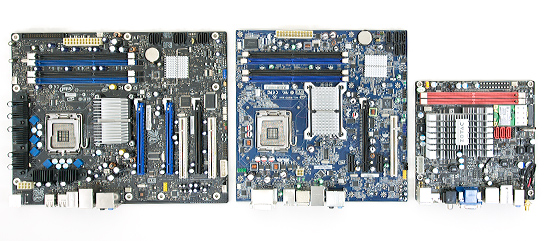
From left to right (ATX, micro-ATX and mini-ITX)
There are two versions of Zotac’s Ion, the ION-ITX-A-U and the ION-ITX-B-E. The more expensive “A” model ships with a dual-core Atom 330 processor, a mini-PCIe WiFi card and an external DC power supply. The “B” model comes with a single-core Atom 230 processor, no WiFi and requires a standard power supply. They are priced at $189 and $139, respectively, from etailers. Add another $10 for retail pricing. Update: Zotac just informed me of two additional versions coming: a C and a D version. The C version will be a single-core product with the DC power supply and the D version will be a dual-core product with no power supply.
Availability will be in limited quantities starting this week. Zotac hopes to have more widespread availability by June.
The first change compared to Intel’s desktop Atom boards is that the Zotac board is entirely passively cooled. While Zotac ships a fan in the box, it’s optional to use. Granted the heatsink on the Zotac Ion is huge, inevitably adding more cost to the board but I’d take that over a spinning fan; the Zotac Ion is completely silent.
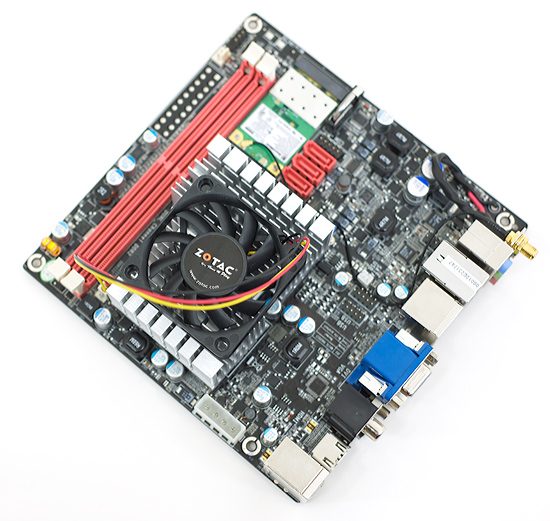
The optional fan
Zotac gives us two DDR2 DIMM slots (4GB max total memory) instead of one on the Intel boards, and it supports up to DDR2-800 memory. While Zotac could’ve opted for DDR3 slots, DDR2 seems like a safer bet since you’re more likely to have spare DDR2 memory laying around these days (especially after you make that upgrade to Phenom II or Core i7).
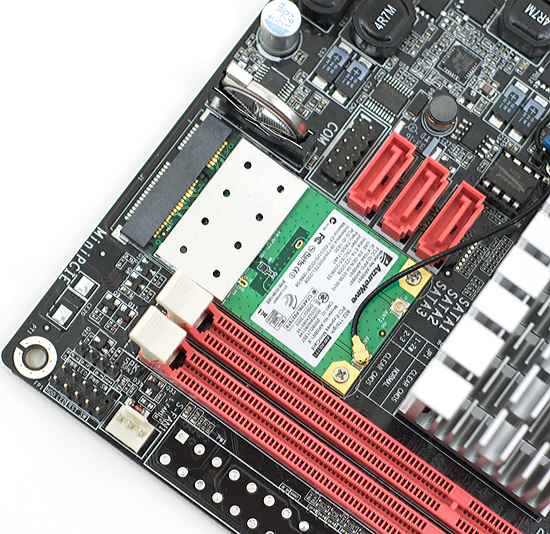
Oooo, expansion
We get three SATA ports instead of two, but no PATA ports. There’s no PCI slot but you do get a mini-PCIe slot for an optional WiFi card.
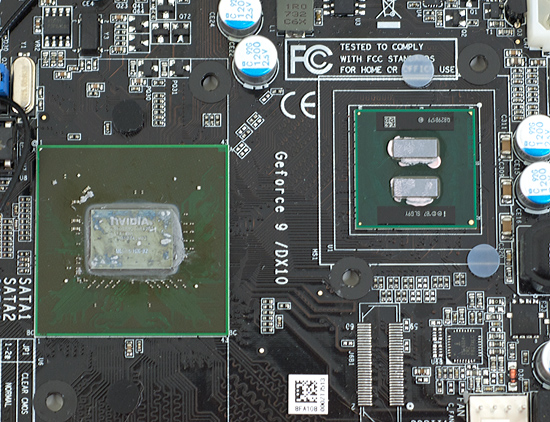
The GeForce 9300, the heart of NVIDIA's Ion platform
On the rear Zotac outfitted the world’s first mini-ITX board with every port you could possibly want. For display output you get everything that matters: VGA, DVI and HDMI. You’ve got three ways of getting audio out of the board: analog, optical or coaxial digital.

Now that's more like it
There are six, count em, six USB 2.0 ports - up from the four on the Intel boards, a single Gigabit Ethernet port (just like on the Intel D945GCLF2), eSATA and a PS2 port. I believe the only feature advantage Intel holds is that its Atom boards have two PS2 ports, one for keyboard and one for a mouse, while the Zotac board only has a keyboard port.
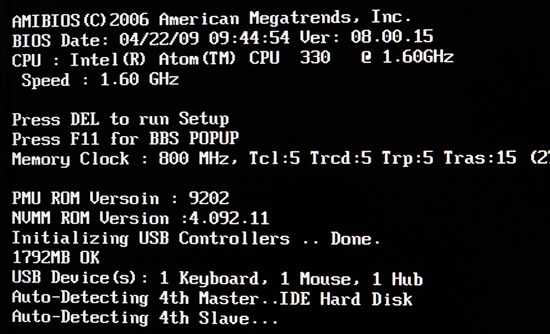
Zotac's POST screen. Spot the spelling error and embarrass Zotac for 15 points.
Assuming you have a USB mouse, Zotac wins hands down in the feature comparison and that’s without giving it extra points for having a way more capable graphics core than the D945GCLF2. I don’t think I’d change a single thing on the Zotac Ion; it’s possibly the manliest Atom motherboard on the market. *grunt*
Unique to the dual-core model I tested is an external DC power supply. The board has no ATX power supply connector on it, instead it relies on an external 90W power brick similar to what you’d get with a large notebook.
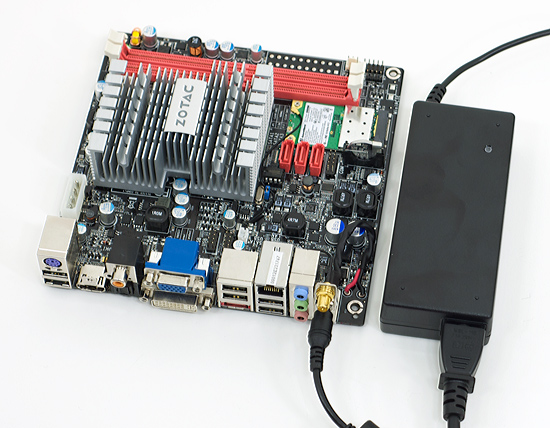
Powah
Just plug the power brick into the I/O panel of the motherboard and you’re good to go. Zotac was careful to put the DC input on the rear of the motherboard so it can still be used in any ITX case, even ones with an internal power supply.
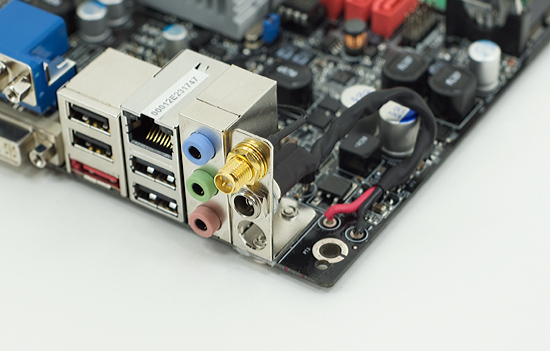
Plug the power brick into the rear panel underneath the WiFi antenna.
There’s a single 5-pin molex connector on the motherboard that can be used to power your SATA drives. Zotac ships the motherboard with a cable that provides three SATA power connectors off of the one on-board molex connector. Given that the board only has 3 SATA ports on it, the 3 power connectors should suffice. Note that they are only SATA power connectors, if you have older drives you’ll need a different cable.
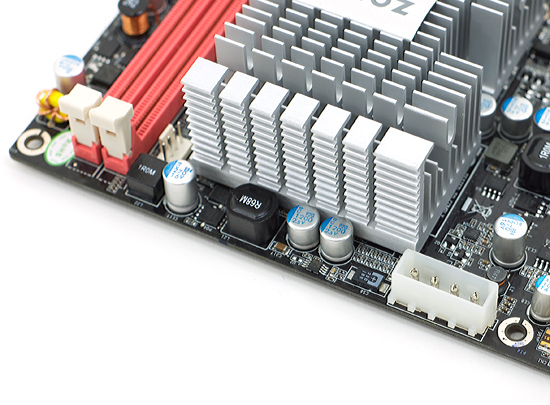
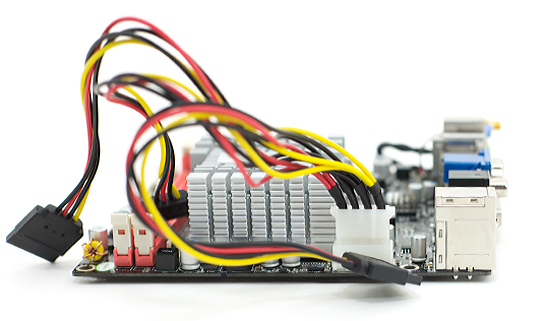
The external power supply is nice to have. It simplifies the construction of your system greatly. You can take the board and pretty much just set it anywhere you want. It’s passively cooled so you don’t need to worry about dust, just don’t put it on anything that conducts electricity.
The only issue I have with the external power supply is that it’s not as easy to replace as a standard ATX power supply. The brick is made by Delta and you might be able to find something with similar specs online, otherwise you’re left asking Zotac for another should something happen to yours.










93 Comments
View All Comments
ahmshaegar - Tuesday, May 12, 2009 - link
Greater power consumption = more heat. Where's that energy going to go?marshylucas - Tuesday, May 12, 2009 - link
You were faster, I was about to reply something similar.Thumbs up for the fanless design!
Jeffk464 - Tuesday, May 12, 2009 - link
Yes, but my laptop is very quiet, even with being severely limited on space for a heat sink and fan. If you had more rooms to put a large heat sink on it with a large low rpm fan, I think it would be near silent.trabpukcip - Friday, May 15, 2009 - link
A laptop does not make the best HTPC though. Connectivity is too limited and is generally inconvenient.GeorgeH - Tuesday, May 12, 2009 - link
"a single Gigabit Ethernet port (just like on the Intel boards)"Actually, only the D945GCLF2 has Gigabit Ethernet. The D945GCLF is stuck with 10/100, which is kind of a deal killer for me.
Anand Lal Shimpi - Tuesday, May 12, 2009 - link
Thanks for the correction :)Take care,
Anand
DrLudvig - Tuesday, May 12, 2009 - link
I'm confused here, most places it says that the hole ION thing is a 9400 chip, while some other places, like now here, says 9300?What is it really?
Anand Lal Shimpi - Tuesday, May 12, 2009 - link
The 9300 and 9400 are the same chip, the difference is GPU clock. Take a look at the table on this page:http://www.anandtech.com/mb/showdoc.aspx?i=3432">http://www.anandtech.com/mb/showdoc.aspx?i=3432
The GF9300 on the Zotac board actually runs a bit slower than the stock GeForce 9300. It runs its core at 450MHz and its shaders at 1.1GHz instead of 450/1.2.
Take care,
Anand
Badkarma - Tuesday, May 12, 2009 - link
Anand,Can you please confirm/deny if the Zotac Ion boards support wake-on-usb? The Zotac 9300 mini-itx board does not support wake-on-usb and therefore powering the system on from standby from the MCE remote does not work without physical workarounds.
Thanks.
Anand Lal Shimpi - Tuesday, May 12, 2009 - link
I'm out of the office right now but I'll try it this weekend :) Drop me an email to remind me if you don't see something by the end of next week :)Take care,
Anand